Photos for Volume 4
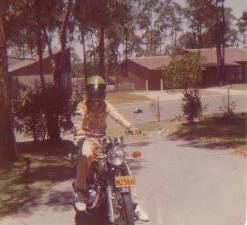 |
|
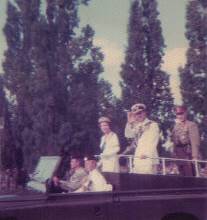 |
Gavin on his
iridescent green Honda CB 200 motorbike in January 1977
(crash-bars fitted later that month), on which while in Year
12 at High School he rode from Sydney to Canberra and back
in March 1977 to see the Royal Visit of the Queen and Duke
of Edinburgh. (See Volume 4 Preface.)
|
|
Queen Elizabeth II
& Philip Duke of Edinburgh, passing by Gavin in an Australia
army Land Rover, at the old Parliament House, on the Silver
Jubilee Royal Visit (1952-1977), March 1977, Canberra,
Australia.
|
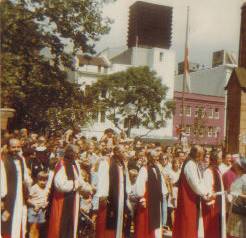 |
|
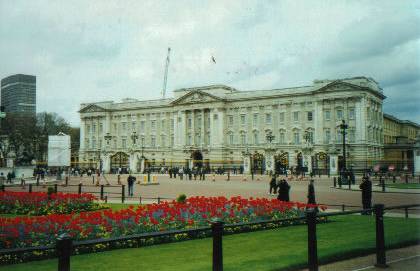 |
Queen (far right),
Supreme Governor of the Church of England, meeting Anglican
Bishops in their white surplices, black preaching scarves,
and red rochets at St. Andrew’s Cathedral, Sydney, Silver
Jubilee Royal Visit (1952-1977), March 1977. (See Volume 4
Dedication.)
|
|
Royal residence of
the Queen of England, Australia, & elsewhere, Buckingham
Palace, London, UK, “in the very merry month of May,” May
2001.
|
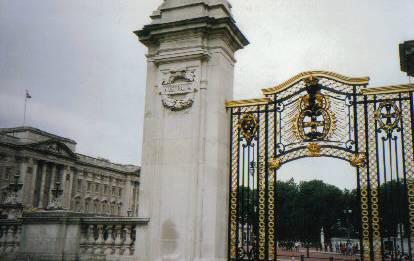 |
|
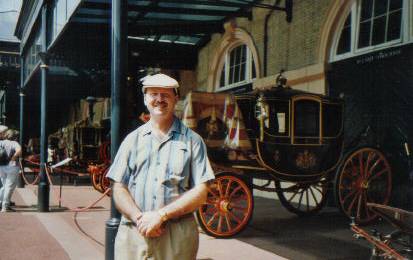 |
One of two
“Australia Gates” at Buckingham Palace, each bearing the
Coats of Arms of three Australian States. This one shows the
Coats of Arms of New South Wales (middle), Victoria (left),
& Queensland (right). June / July 2001.
|
|
Gavin in front of
royal coach used to convey the Sovereign from Buckingham
Palace to Westminster Parliament in London, The Mews,
Buckingham Palace, Aug. 2001.
|
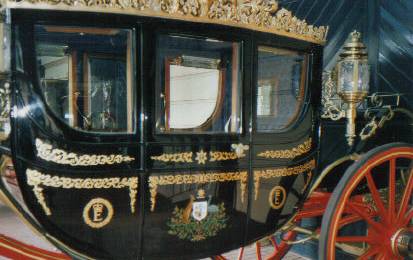 |
|
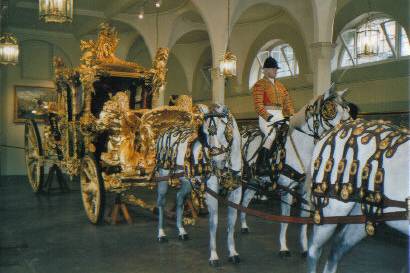 |
The Australian
royal coach, bearing the Australian Coat of Arms on its
door, & presented to Queen Elizabeth II from Australia as
part of the 1988 Bicentennial (1788-1988) Celebrations. The
Mews, Aug. 2001.
|
|
The gold royal
coach of King George III (Regnal Years: 1760-1820), “the
king who won Australia & the king who lost America,” The
Mews, Aug. 2001.
|
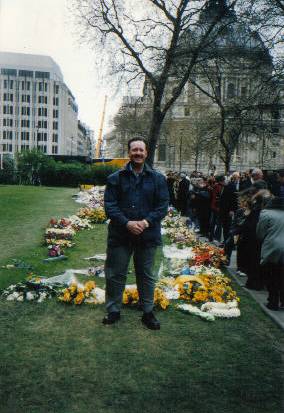 |
|
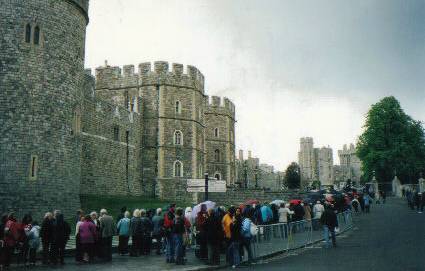 |
Gavin at
Westminster Abbey, London, in front of flowers given for the
Queen Mother’s funeral, April, 2002. (See Volume 4 Sermon.)
|
|
Queues line up at
Windsor Castle to see the Queen Mother’s grave in the Castle
Chapel, April 2002. (See Volume 4 Sermon.)
|
 |
|
 |
Flowers for the
Queen Mother’s funeral outside St. George’s Chapel, Windsor
Castle, April 2002. (See Volume 4 Sermon.)
|
|
“Sing tow, row,
row, row, row, row, for the British Grenadiers,” Windsor
Castle, England, April 2002.
|
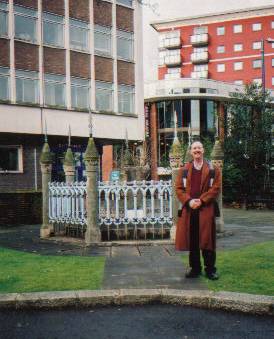 |
|
 |
Gavin at
Coronation Stone at Kingston-Upon-Thames (also known as
Kingston) in London, Feb. 2009.
|
|
The old Saxon
Coronation Stone next to Clattern Bridge, at which seven
Saxon kings were crowned in the 10th century, Kingston, Feb.
2009.
|
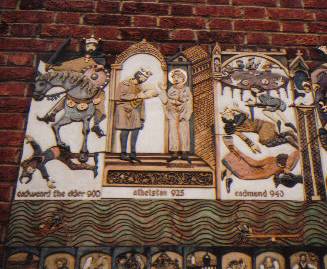 |
|
 |
Mosaics at Cnr of
Ashdowne Rd & Eden St. showing the seven Saxon kings crowned
at Kingston, Feb. 2009. From left to right: Edward the Elder
in 900; Athelstan in 925; & Edmund in 940. (Continued in
next photo).
|
|
Mosaics continued
from last photo. From left to right: Edred in 946; Edwy in
956; Edward in 975 drinking the poison stirrup cup given to
him from his evil step-mother when he was 16, he is
remembered with black-letter days in the 1662 BCP Calendar
on 18 March (Edward, King of the W. Saxons) & 20 June
(Translation of his remains to Shaftsbury); & Etheldred the
Unready in 979.
|
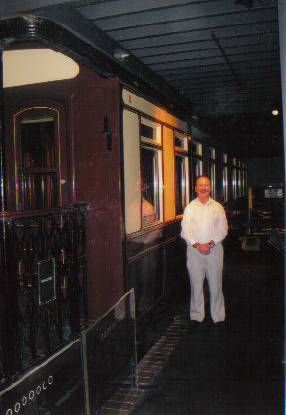 |
|
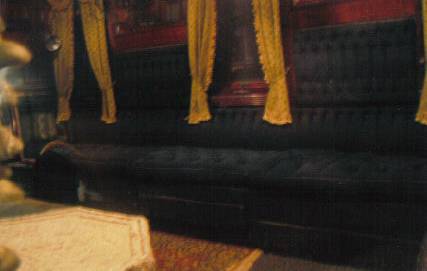 |
Gavin at the
Governor’s Carriage, Powerhouse Museum in Sydney, Jan. 2011.
Built in 1891, when in operation as a train carriage it
conveyed both vice-regal and royal passengers in New South
Wales.
|
|
Interior of NSW
Governor’s Carriage, Powerhouse Museum, Sydney, Jan. 2011.
(See Volume 4 Dedication.)
|
 |
|
 |
Gavin before a
1662 BCP Service in front of the white office building at
St. Philip’s Church Hill, York Street, inner city of Sydney
(near the Harbour Bridge), known as “St. Philip’s Parish
House.” It was Dedicated on the anniversary of the 20 year
reign of Elizabeth II (1952-1972), on Accession Day, 6
February, 1972, at the start of her 21st regnal year. A
plaque inside it says it was “opened by” “Sir Paul Hasluck,”
who as “Governor-General of Australia” was the Federal
representative of the Crown from 1969 to 1974, “and
dedicated by Marcus “Loane,” the “Archbishop of Sydney and
Metropolitan of New South Wales,” “on Sunday 6 February,
1972.” Trinity Sunday 25 (red-letter day), & King Edmund’s
Day (black-letter day), 20 Nov. 2011. (See Volume 4
Dedication.)
|
|
The Minister
(Bishop Ray Smith) at St. Philip’s York Street, at a 1662
Book of Common Prayer Service of Holy Communion. The
Communion elements have been moved to the north end of the
Lord’s Table for the Prayer of Consecration (paten in
Minister’s hands, Chalices on Table to far right of photo).
This accords with BCP rubric for the Minister to be
“standing at the north side,” “before the” Lord’s “Table,”
so that his actions are “before the people” during “the
Prayer of Consecration.” This was found to be a useful and
good practice not “contrary to God’s Word” or not “against
God’s Word” (Articles 20 & 34, 39 Articles). The Puritans
objected and opposed this as an Anglican practice, claiming
that the Minister should always face the people, rather than
“turning to the people” from this northward position to
e.g., “pronounce” the “Absolution.” The Papists objected and
opposed this as a Protestant practice, claiming that the
Table was “an altar,” and that the Romish priest should
stand in the middle of it with his back to the people at the
Roman Mass, & then elevate the bread in order for it to be
idolatrously adored by the congregation; whereas the
Anglican Protestants said, “no adoration … ought to be done,
either unto the sacramental bread or wine … for that were
idolatry to be abhorred of all faithful Christians …” (Final
Rubric, Communion Service, 1662 Book of Common Prayer).
Trinity Sunday 25, “Stir up Sunday” (in-house BCP Anglican
name for the day), Sunday before Advent, 20 Nov. 2011. (See
Volume 4 Dedication.)
|
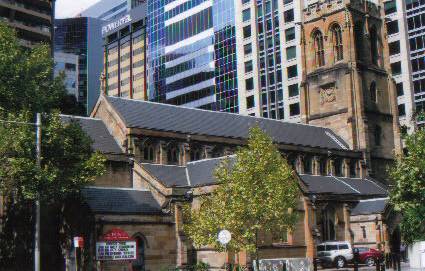 |
|
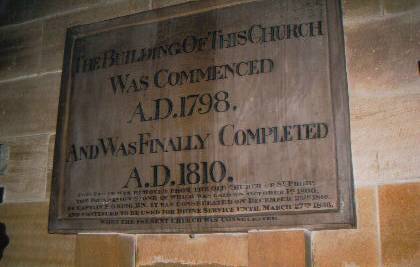 |
The Queen’s 59th
Accession Year (1952-2011), & commencement of her 60th
regnal year. St. Philip’s Church Hill, York Street,
Accession Day, Sunday 6 Feb. 2011, after a service from the
1662 Book of Common Prayer. The 1662 prayer book
traditionally has printed at the front of it the 1559 Act of
Elizabeth I (Regnal years 1558-1603) which refers to how
Cranmer’s 1552 “Book of Common Prayer … was repealed, and
taken away by … Queen Mary, to the great decay of the due
honour of God, and discomfort to the professors of the truth
of Christ’s religion;” one of whom was the Protestant
Archbishop Thomas Cranmer, who became a Marian martyr. This
makes the point that Cranmer’s 1552 prayer book was taken
away by the Romanists under Bloody Mary, and revived as a
symbol of Protestantism in the 1559 prayer book, and now
found as a symbol of Protestantism in the 1662 prayer book.
(See Volume 4 Dedication & Sermon.)
|
|
Old plaque inside
Church. The parishes, though not the church buildings, of
St. Philip’s (inner City of Sydney) and St. John’s
Parramatta (western Sydney) are the two oldest parishes in
Australia, being formed by order of the NSW Governor in
1802. His Excellency Governor Philip King, as the
representative of King George III ordered the formation of
the parishes of “‘Saint Phillip,’ in honor of the first
Governor of this territory,” Arthur Phillip, and “‘St.
John’s,’ in honor of the late Governor, Captain John Hunter;
and the churches … at Sydney and Parramatta be respectively
named Saint Phillip and Saint John.” But when the new parish
church was built in 1856, “St. Phillip’s” with a double “l”
in memory of Arthur Phillip, was renamed and consecrated as
“St. Philip’s” with a single “l” in memory of the Apostle
Philip.
|
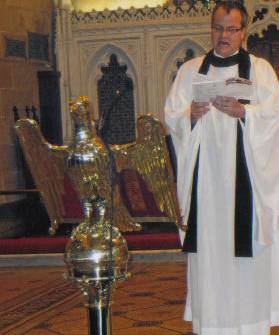 |
|
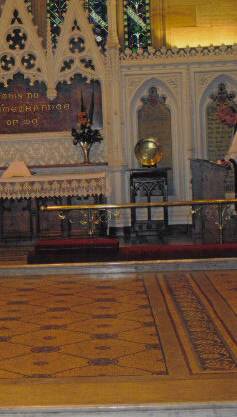 |
Minister (Rev. Mr. Justin Moffatt), at a 1662 Book of Common
Prayer Service, St. Philip’s York Street, Accession Day,
Sunday 6 Feb. 2011.
|
|
BCP Service at St. Philip’s: Accession Day, Epiphany 5, &
Richard Johnson’s Day (transferred from 3 Feb. to following
Sunday), Sunday 6 Feb. 2011. The Chancel Table set for
Communion with a fair white linen cloth upon it is elevated
for visibility by the congregation, so that e.g., the
actions of the Minister at "the Prayer of Consecration" when
he is "standing before the Table" "at the north side" are
"before the people" (1662 BCP rubric). I.e., the Lord's
Supper is "ministered according to Christ's ordinance"
without any need for the elements to be "lifted up" in front
of the people “to be gazed upon;” since the church has found
from experience that any such non-visibility such as would
occur with a non-elevated table at the church's east end,
may result in superstitious notions connected with actual or
perceived secrecy with the people not being able to see the
consecration (such as occurred at the pre-Vatican II Roman
Mass with the Roman Catholic priest blocking visibility of
consecration by having his back to the people); whereas if
the elements are “lifted up” in order to achieve “more
dramatic” visibility by the people (such as done at both the
pre & post Vatican II Council Roman Mass), this then also
facilitates, and in some people excites, “adoration” which
is “idolatry” contrary to I Cor. 5:11; 8:9,11-13; 10:14
(Articles 19, 22, 25 & 28, Anglican 39 Articles & Final
Rubric 1662 BCP Communion Service; see Bishop Ray Smith in
above photo). In the
Chancel i.e., the area at the church’s east end behind the
Communion rail where Communicants kneel on the cushions to
receive Communion; far left – Paten & Challices under white
Communion veil at centre of the Table; right of centre -
Offertory plate, which after the Collection monetary bags
are put in it, is placed on the holy Table; & far right -
Bishop Ray Smith (a retired auxiliary Bishop of Sydney
Diocese, formerly Bishop of Liverpool in western Sydney).
|
 |
|
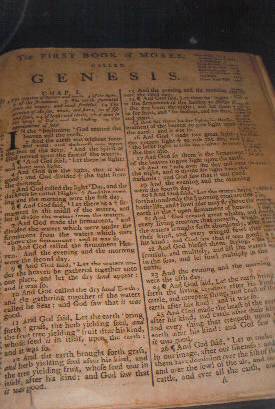 |
Gavin with a Queen Elizabeth rose (named after Elizabeth II)
in his lapel, holding two Communion patens given by King
George III in 1803. St. Philip’s, Accession Day, Sunday 6
Feb. 2011.
|
|
The Reverend Richard Johnson was an Evangelical Anglican
clergyman. He was the New South Wales Chaplain who conducted
the first Christian service in Australia on 3 Feb. 1788. He
was given this Authorized Version when commissioned as
Chaplain of the First Fleet on 24 Oct. 1786, the Eve of
Accession Day of George III. This Bible is the property of
St. Philip’s and brought out on special occasions. Page
showing Genesis 1 of Johnson’s King James Bible. St.
Philip’s, Accession Day, Sunday 6 Feb. 2011.
|
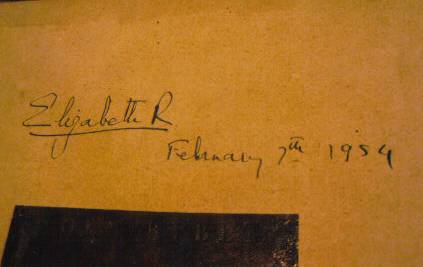 |
|
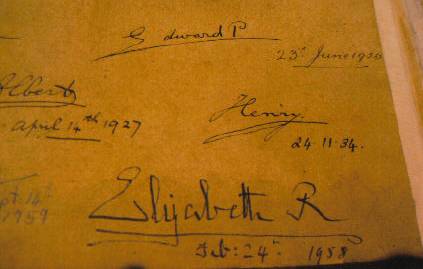 |
The inside cover of Johnson’s Bible autographed by Elizabeth
II in 1954. St. Philip’s, Accession Day, Sunday 6 Feb. 2011.
(See Volume 4 Dedication.)
|
|
The inside cover of Johnson’s Bible autographed by various
members of the Royal Family on Royal Visits to Australia.
“Edward P” in “1920”, i.e., Edward, Prince of Wales, later
King Edward VIII (Regnal Year: 1936). “Albert” in “1927”
i.e., Prince Albert, Duke of York, later King George VI (Regnal
Years: 1936-1952). “Henry” in “[19]34” i.e., Prince Henry,
Duke of Gloucester, the third son of George V (Regnal Years:
1910-1936), who was later Governor-General of Australia
(1945-1947). And “Elizabeth R[egina, Latin, ‘Queen’]” in
“1958.”
|
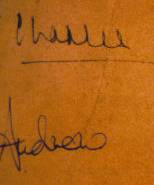 |
|
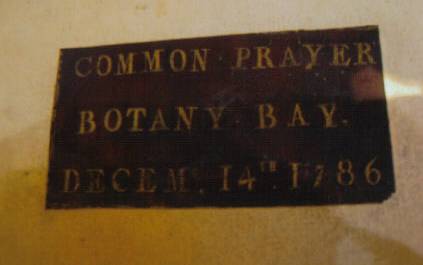 |
The inside cover of Johnson’s Bible autographed by various
members of the Royal Family on Royal Visits to Australia.
E.g., Prince “Charles” in “1983,” and Prince Charles’
brother, “Andrew,” in the Australian 1788-1988 bicentennial
year of “1988”.
|
|
Johnson’s Book of Common Prayer, for “Botany Bay” NSW. This
1662 BCP is the property of St. Philip’s and brought out on
special occasions. St. Philip’s, Accession Day, Sunday 6
Feb. 2011.
|
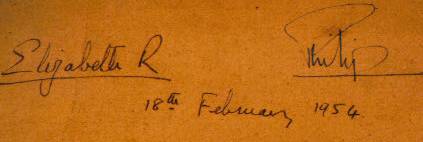 |
|
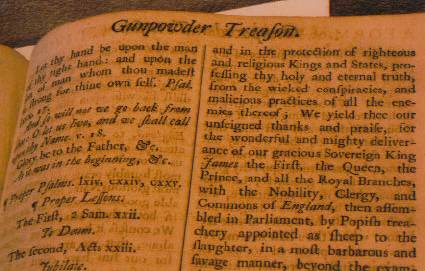 |
The inside cover of Johnson’s Book of Common Prayer,
autographed by “Elizabeth” II and “Philip” Duke of Edinburgh
in “1954.” St. Philip’s, 6 Feb. 2011. (See Volume 4
Dedication.)
|
|
The Office of “Gunpowder Treason” Day or Papists’ Conspiracy
Day (5 Nov.) in Johnson’s 1662 Book of Common Prayer. St.
Philip’s Church Hill, 6 Feb. 2011.
|
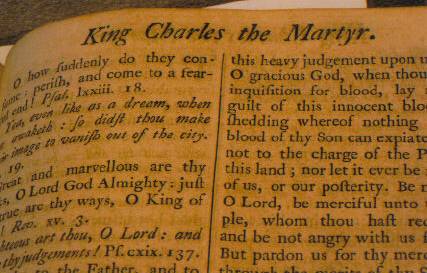 |
|
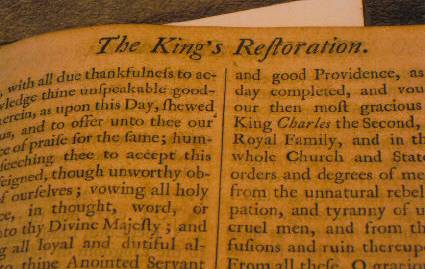 |
The Office of “King Charles the Martyr” (30 Jan.) in
Johnson’s 1662 Book of Common Prayer. St. Philip’s, 6 Feb.
2011.
|
|
The Office of “The King’s Restoration” (29 May) in Johnson’s
1662 Book of Common Prayer. St. Philip’s Church Hill, York
Street, 6 Feb. 2011.
|
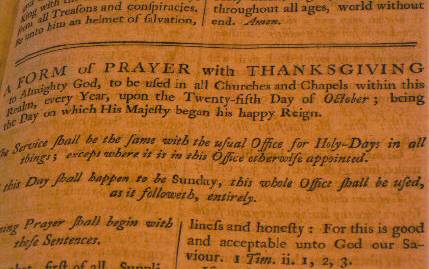 |
|
 |
The Office of Accession Day (25 Oct.) for George III (Regnal
Years: 1760-1820) in Johnson’s 1662 Book of Common Prayer.
St. Philip’s, 6 Feb. 2011.
|
|
The Accession Service for George III annually on 25 October,
in Johnson’s 1662 Book of Common Prayer. St. Philip’s York
Street, City of Sydney, 6 Feb. 2011.
|
 |
|
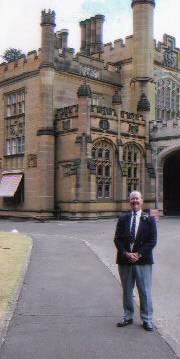 |
Government House of NSW, next to Hyde Park, 6 Feb. 2011.
Used in connection with State occasions involving the NSW
Governor, and connected with a residence.
|
|
Gavin with a Queen Elizabeth rose in his lapel, NSW
Government House, Accession Day, Sunday 6 Feb. 2011, the
59th Accession Day of Elizabeth II (1952-2011), commencing
her 60th regnal year. (See Volume 4 Dedication.)
|
 |
|
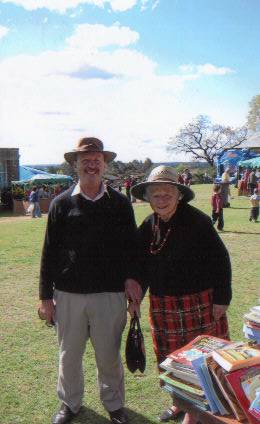 |
St. Matthew’s Fair, “a very Anglican local tradition,” is
generally held in September, the same month as St. Matthew’s
Day (21 Sept.). The large church yard of St. Matthew’s
Windsor in western Sydney is divided by a road, and the Fair
is held on the Rectory side of the road. Some of the stalls,
marquees, and gazebos of St. Matthew’s Fair, together with a
blue blow-up castle for children to play in (centre back),
and the church hall (left brick building) containing food
stalls and a Coffee Shop.
|
|
Gavin with his Mother next to a bookstall at the annual St.
Matthew’s Fair, in the church yard of St. Matthew’s Windsor,
Saturday, 3 Sept. 2011. (See Volume 4 Dedication & Sermon.)
|
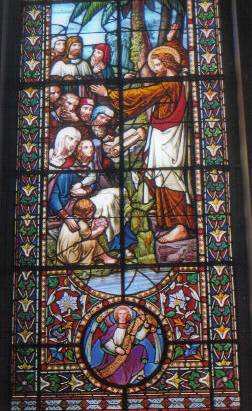 |
|
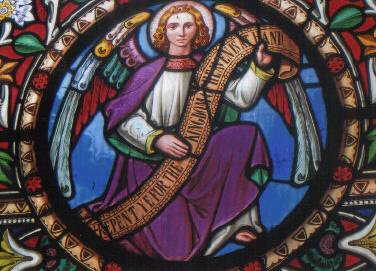 |
A stained glass window at St. Matthew’s Windsor, Sydney,
with the words of the Authorized Version from Matt. 3:2 with
St. John Baptist saying, “Repent ye for the kingdom of
heaven is at hand.” 1662 BCP Service, Reformation Sunday
(the Sunday on, or near, the Eve of All Saints’ Day), 30
Oct. 2011.
|
|
Close of up AV’s words of Matt. 3:2, “Repent ye for the
kingdom of heaven is at hand,” before a 1662 Book of Common
Prayer Service on Reformation Sunday 30 Oct. 2011 (church
service transferring remembrance of Luther’s 95 Thesis in
1517 from the Eve of All Saints’ Day back to the nearby
Sunday).
|
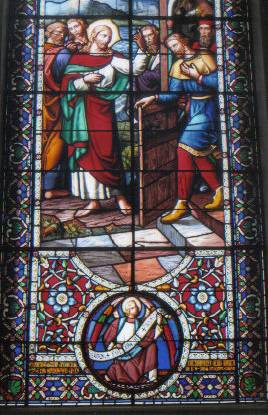 |
|
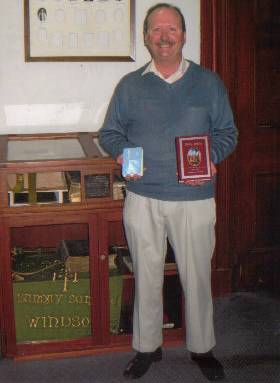 |
Stained glass window at St. Matthew’s Windsor with AV’s
words of Matt. 9:9 spoken to Matthew by Christ, “Follow me.”
Sunday 30 Oct. 2011, being the Sunday before Gunpowder
Treason Day, Saturday 5 Nov. 2011 (next photo).
|
|
Gavin with the 1611-2011 Cambridge University Press
“Transetto Edition” 400th anniversary edition of the King
James Bible (right hand) and The Trinitarian Bible Society
1611-2011 Commemorative Edition (left hand), in front of a
display case at St. Matthew’s Anglican Church Windsor,
Sydney, containing an 1821 print of a King James Bible sent
out by King George IV to St. Matthew’s which was used as the
pulpit Bible till 1936. Papists’ Conspiracy Day, Sat. 5 Nov.
2011, remembering God’s deliverance of the Protestant King
James and Parliament from the Popish treachery of Guy Fawkes
and others to blow them up with gunpowder in 1605, the year
after King James decided in the 1604 Hampton Court Palace
Conference to translate the King James Bible which was then
completed and published in 1611. (See Volume 4 Dedication &
Sermon.)
|
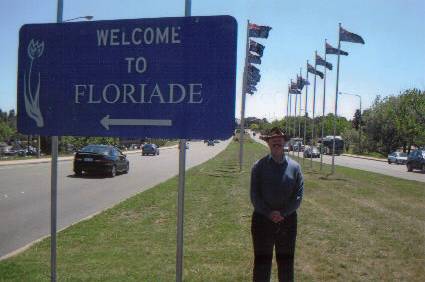 |
|
 |
Gavin in Canberra on 20 & 21 Oct. 2011 for the Royal Visit.
The Floriade flower show was the destination for the Queen &
Duke of Edinburgh on their barge trip of 21 Oct. 2011. (See
Volume 4 Dedication.)
|
|
Part of the Floriade, Commonwealth Park Gardens, next to
Lake Burley Griffin, Canberra, Australian Capital Territory,
Wed. 20 Oct. 2011.
|
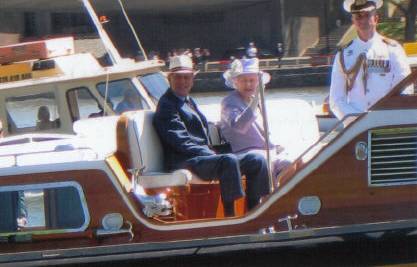 |
|
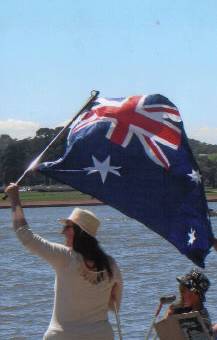 |
The Queen waves as she goes past Gavin. Her Majesty Queen
Elizabeth II & His Royal Highness, the Duke of Edinburgh, in
the Admiral’s Barge on Lake Burley Griffin, en route to the
Floriade, Canberra, ACT, Thurs. 21 Oct. 2011.
|
|
One of the Australian flags which was waved to welcome the
Queen of Australia, Lake Burley Griffin, Canberra, Thurs. 21
Oct. 2011. (See Volume 4 Dedication.)
|
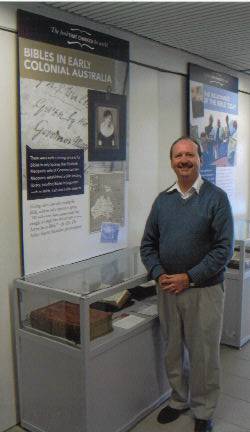 |
|
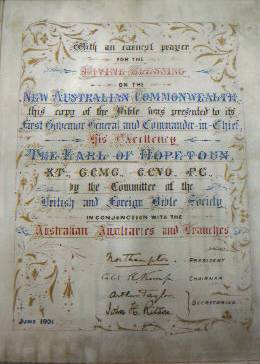 |
Gavin next to the 1773 print of the Authorized Version
(large brown Bible at end of cabinet) of John Hunter, NSW
Governor (1795-1800), representative of King George III.
Bible Society Exhibition for 400th year celebration of the
King James Version (1611-2011), Village Church, Annandale,
July 2011. (See Volume 4 Dedication.)
|
|
Title page of King James Version presented as part of the
Australian Federation celebrations to Lord Hopetoun, the
first Governor-General of Australia (1901-1903),
representative of Victoria and King Edward VII (who acceded
to the throne in 1901). Bible Society Exhibition for the KJV
(1611-2011), Annandale (Sydney), July 2011.
|
 |
|
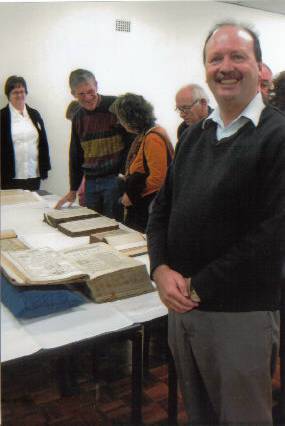 |
An original 1611 print of the King James Version. King James
Conference Day (1611-2011), Moore Theological College,
Sydney, 7 July 2011. (See Volume 4 Dedication.)
|
|
Gavin next to an original 1611 print of the King James
Version. King James Conference Day (1611-2011), Moore
Theological College, Sydney, 7 July 2011.
|
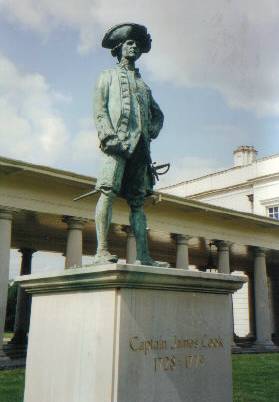 |
|
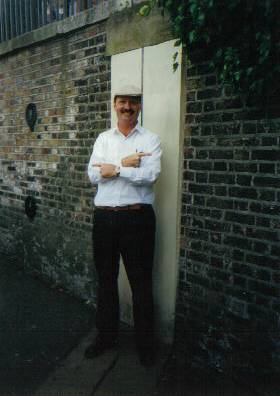 |
Greenwich in London, UK, is being made a Royal Borough as
part of the 2012 Diamond Jubilee celebrations of Queen
Elizabeth II, Queen of England, Australia, & elsewhere,
Supreme Governor of the Church of England, Defender of the
Faith. Statue of Captain James Cook, navigator and
discoverer of eastern Australia in 1770, next to Queen’s
House, Greenwich Park, London, June 2001. (See Volume 4
Dedication.)
|
|
Gavin at the Greenwich Royal Observatory, the world’s Prime
Meridian, Meridian O°, used to reckon longitude, Greenwich
Park, London, June 2001. Gavin’s left hand points west and
his right hand points east; but is his longitude east or
west of the prime meridian?
|
 |
|
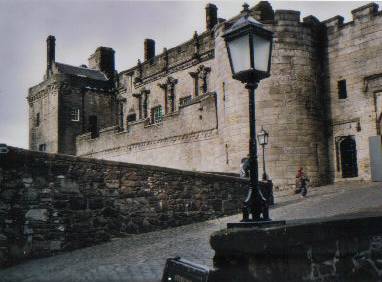 |
Royal Salutes are fired to the Queen on 6 February, being
Accession Day, in various places e.g., Dover Castle in
England. Dover Castle in Jan. 2002.
|
|
Another place that fires a Royal Salute to the Queen on
Accession Day is Stirling Castle in Scotland. Stirling
Castle in Oct. 2008. (See Volume 4 Dedication.)
|
 |
|
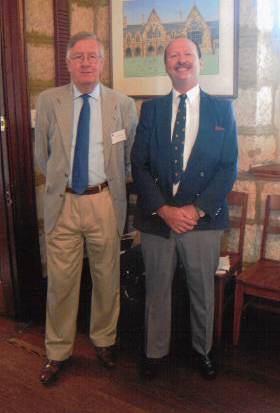 |
Symposium on the 350th anniversary of the 1662 Book of
Common Prayer at St. Paul’s College Sydney University, St.
Andrew’s Day, Wed. 30 Nov. 2011. Held 3 days after the
Anglican liturgical year for 2011-2012 commenced on the
First Sunday in Advent. Common Room where Lectures were held
(centre) and Dining Hall (right).
|
|
Christopher Haigh, before his retirement in 2009 the Head of
the Oxford University History Faculty in England (left) & an
old Pauline, Gavin, wearing the tie of St. Paul’s College
(right). Haigh’s morning lecture on the 1662 BCP was
entitled, “Introducing the Prayer Book in 1552 and 1662.”
(See Volume 4 Dedication.)
|
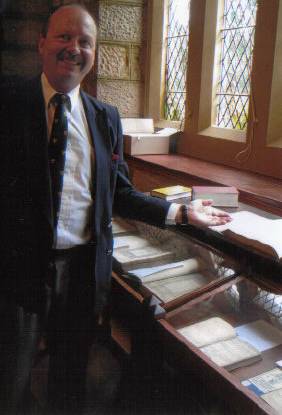 |
|
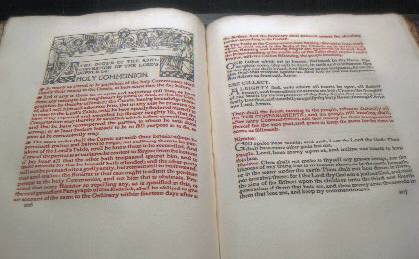 |
Gavin in front of a Display Cabinet in the Common Room of
St. Paul’s College set up for the Symposium by Moore
Theological College Library, containing e.g., an original
print of Cranmer’s 1549 prayer book, an original print of
Cranmer’s 1552 prayer book, and an original 1662 print of
Cranmer’s prayer book revised by the Savoy Conference of
1661 before becoming the 1662 Book of Common Prayer. St.
Andrew’s Day, 2011.
|
|
BCP opened at the Service of Holy Communion, the 1662 prayer
book on top of the Display Cabinet Gavin is pointing to in
the previous photo. This is a limited 400 copy special
edition of the 1662 BCP issued for the coronation of King
Edward VII (Regnal Years: 1901-1910). Symposium on the 350th
anniversary of the 1662 Book of Common Prayer at St. Paul’s
(Anglican) College, Sydney University, Wed. 30 Nov. 2011.
|
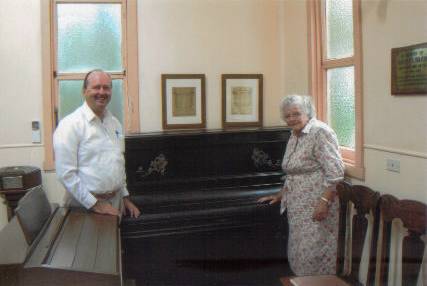 |
|
 |
Mangrove Mountain Union Church Centenary gift piano
(1912-2012). After the piano was delivered to the church in
rainy conditions on the Eve of Australia Day (Wed. 25 Jan.),
Gavin behind church organ and next to piano with his mother,
who both gave the piano a woodwork furniture polish on
Australia Day (26 Jan.), 2012. Formerly belonging to Gavin’s
matrilineal grandmother, this piano dating from about 1900,
won 1st prize at a Sydney Exhibition, and was the first
German iron-frame piano put in a Beale piano case. A pianist
can truly “tickle the ivories” on this piano as unlike more
modern pianos from around the mid 20th century on, the white
ivory piano keys are overlaid with strips of genuine white
ivory.
|
|
Gavin with a Queen Elizabeth Rose (named after Elizabeth II)
in his lapel, and another Queen Elizabeth rose on top of
piano, holding ten 1662 Books of Common Prayer (Nos. 1-6
from his matrilineal grandmother & mother; No. 7 belongs to
his mother; Nos. 8 & 9 from his mother; & No. 10 he bought),
with Accession Service Royal Warrants from the time of
Victoria to Elizabeth II. In front of piano given by Gavin &
his Mother to Mangrove Mountain Union Church as part of the
Church’s 1912-2012 Centenary. Accession Day, Queen’s Diamond
Jubilee, 60th Anniversary (1952-2012) of Elizabeth II, Mon.
6 February, 2012, at start of her 61st regnal year. (See
Volume 4 Dedication & Sermon.)
|
|
|
|
|
|